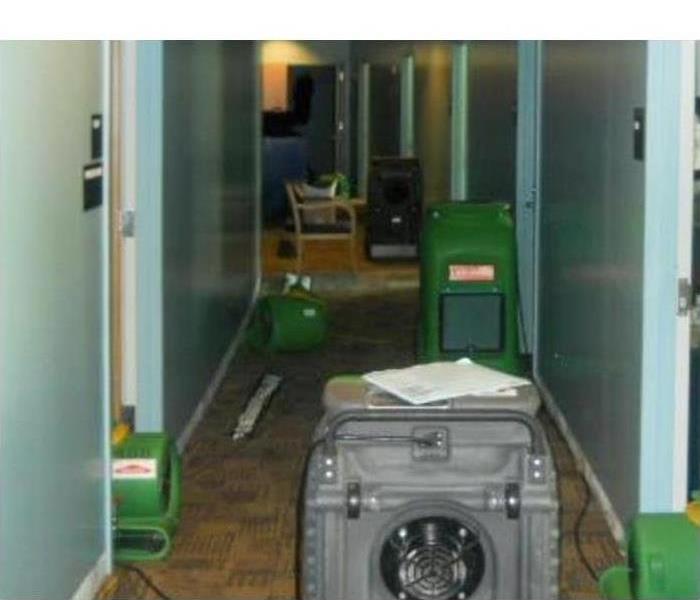How Long Does the Water Damage Restoration Process Take?
12/16/2022 (Permalink)
 SERVPRO of Haywood and Transylvania Counties have all the equipment needed to help you after water damage.
SERVPRO of Haywood and Transylvania Counties have all the equipment needed to help you after water damage.
Steps In the Water Clean Up and Repair Process
Water damage is a serious issue that you don’t want to take lightly. Water can cause a variety of issues, including mold growth, structural damage and more. It’s important to hire a professional water damage restoration company who can help you assess the extent of the damage as quickly as possible and then take steps to rectify it. At SERVPRO of Haywood & Transylvania, we provide 24/7 emergency services for all types of residential and commercial water damage situations.
Step 1: Assess the damage
The first step of water damage restoration is to assess the damage. Before your restoration company can begin treatment and repair, they need to know what kind of damage has occurred and how severe it is. It's important to note that this process will be different depending on what caused the water problem in your home or business.
Water damage can be caused by many things, including:
- A burst pipe
- A broken dishwasher hoses
- Faulty sump pump maintenance
- Heavy rains or flooding due to natural disasters like hurricanes or tornadoes
Step 2: Containment and extraction
Containment and extraction are the two most important steps in the water damage restoration process. After you call us, we will come out to your home or office and start the containment process immediately. The goal of containment is to prevent further damage from occurring by creating a barrier between the wet area and any dry areas nearby that could be affected by water damage.
Containment can be done in a few different ways: using tarps or other waterproof materials, moving furniture away from walls and repairing broken windows or doors so that moisture does not continue to enter an area it shouldn't (like through cracks around windows). If there is standing water present after these actions have been taken, then we will also place absorbent pads underneath rugs/carpets where they rest on subfloors/panels so they do not become saturated as well (this can lead to mold growth if left untreated). Once all these things have been completed then we begin extracting excess moisture with specialized equipment designed specifically for this purpose!
Step 3: Drying and dehumidification
Drying and dehumidification are two separate processes that can be done simultaneously. Drying refers to the process of removing water from the structure, while dehumidification is the lowering of humidity in your home or building. The purpose of this step is to prevent mold growth.
Step 4: Cleaning and sanitizing
After water damage has been removed, your next step is to clean and sanitize the affected area.
Cleaning usually involves using a mild detergent (such as dish soap) and water to remove any remaining residue from a cleaning solution. In many cases, simply wiping down an affected area with warm running water will be enough to clean most surfaces.
Sanitizing is more involved than simply cleaning because of the pathogens still present in your Dellwood, NC home after cleanup efforts begin. The purpose of sanitizing in this stage of restoration is primarily disinfection: killing off bacteria and other microorganisms that may be living on your walls or floors after flood damage has been removed.
Step 5: Restoration
Once the water damage has been removed, it's time to start the restoration process. Restoration can be done by a professional contractor or by the homeowner with the help of a professional. Restoration can be done to the interior or exterior of a structure, such as flooring and walls, or it can be done on smaller items like furniture and electronics — even jewelry!
If you're looking for a way to save money and get your restoration completed quickly, hiring a professional is always recommended because they have experience in working with all types of water-damaged properties. If you want to do all your own work but still want help from someone who knows how long this process takes on average (and why), consider contacting us today!
The time it takes for water damage repair depends on a variety of factors.
To get an idea of how long it will take to restore your home after a water damage event, consider the following factors.
- The size of the area affected. If you have only a small amount of water damage in your house, then the process should be straightforward and take a minimal amount of time to complete. However, if there is more extensive damage throughout most or all parts of your home, then this may require more time and resources to repair (and thus cost more).
- The extent of the damage. Water can cause significant destruction when it seeps into walls or floors—even if there isn't much visible evidence initially.
- Type material damaged by water contact: For example: wood floors are sensitive because they absorb moisture easily – so less dampness means less wear-and-tear over time – whereas vinyl floors tend not suffer much at all.
The time it takes for water damage repair depends on a variety of factors. The amount of water that was spilled, the amount of damage to your property and how quickly you act will all impact how long the restoration process will take. If there is significant damage or if you wait too long before calling in professionals, then this could lead to more extensive repairs down the road.



 24/7 Emergency Service
24/7 Emergency Service